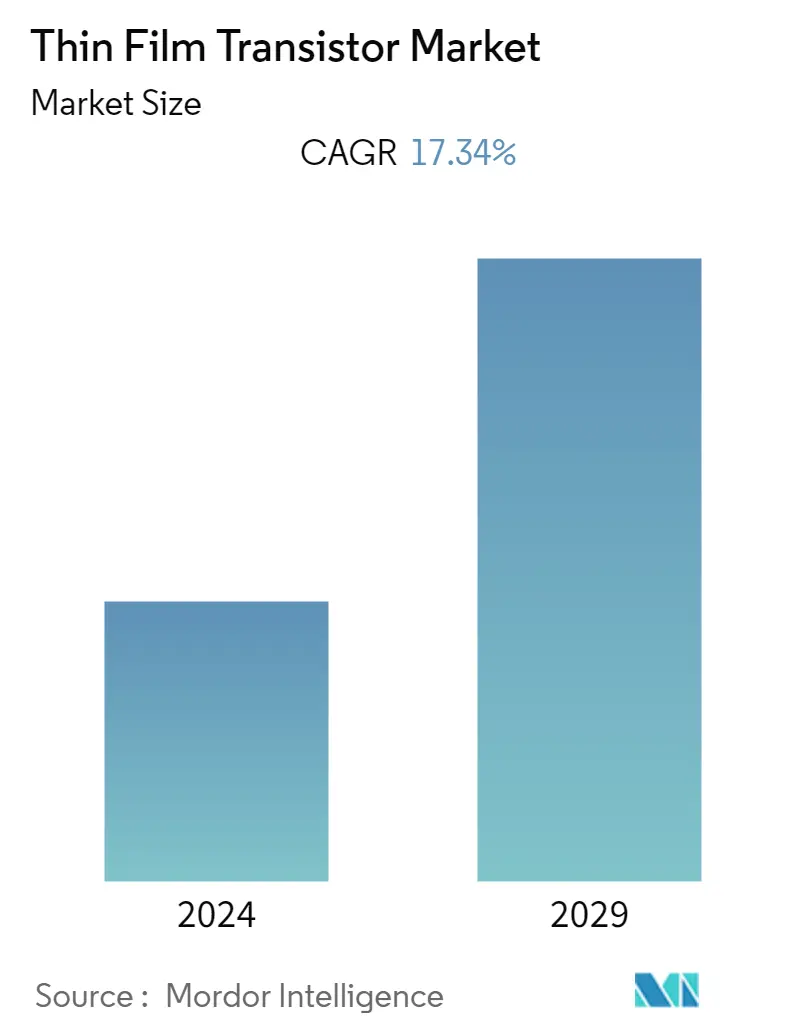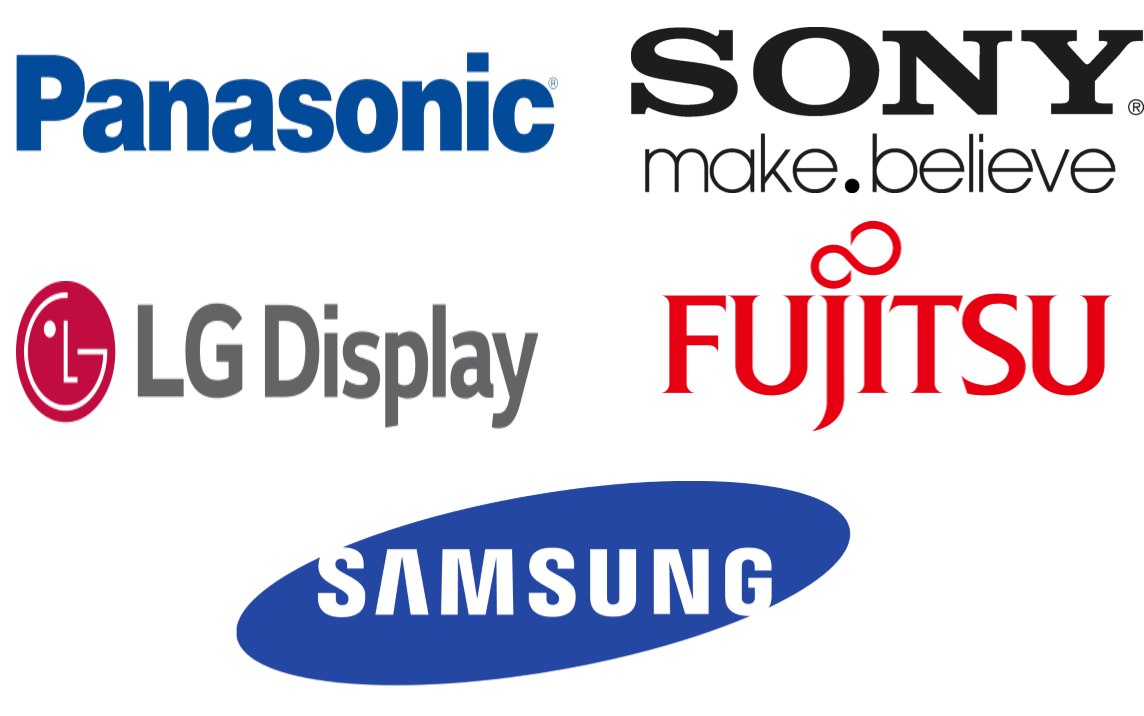Market Size of Thin Film Transistor Industry

| Study Period | 2019 - 2029 |
| Base Year For Estimation | 2023 |
| CAGR | 17.34 % |
| Fastest Growing Market | Asia Pacific |
| Largest Market | North America |
| Market Concentration | Low |
Major Players
*Disclaimer: Major Players sorted in no particular order |
Thin Film Transistor Market Analysis
The thin-film transistor market is expected to register a CAGR of 17.34% over the forecast period (2021 - 2026). Thin-film transistors (TFTs) are critical elements used for thin film electronics, and their most important application includes the pixel switching elements on flat panel displays (FPDs). A thin film transistor is also known as matrix display technology, which is more responsive to change.
- The thin film transistors are expected to have a higher growth rate in the forecast period due to features such as low price, increasing demand of compact size, low power consumption displays, reduced weight and in consumer electronic goods and rising disposable incomes. Due to the continuous innovation in technology, there is an increase in the demand for thin film transistor displays.
- Less availability of high-resolution TFTs for professional applications and high cost of manufacturing are some of the factors responsible for hindering the growth of the market. The market has various opportunities in the field of robotics, flexible electronics, and medical science. The excellent growth potential in emerging economies is also expected to drive the market.
- TFT technology is investigated for use in microelectronic devices, X-ray detection, biochemical sensing, and chemical sensing. The technology offers advantages such as low power consumption, low cost, better response time, and faster refresh rate. Most of the companies are in the process to develop organic TFT technology, which makes it possible to have flexible display surfaces.
Thin Film Transistor Industry Segmentation
Thin film transistors are electronic control devices which are fabricated on large transparent substrates. A TFT is a field-effect transistor (FET) which comprises of three terminals (gate, source, and drain) and includes semiconductive, dielectric and conductive layers. Thin-film transistors (TFTs) are critical elements used for thin film electronics, and their most important application includes the pixel switching elements on flat panel displays.
| By Fabrication Type | |
| Organic | |
| Inorganic |
| By Product Type | |
| Liquid Crystal Display | |
| Light Emitting Diode | |
| Electronic Paper Display | |
| AMOLED |
| By End-user Industry | |
| Consumer Electronics | |
| Automotive | |
| BFSI | |
| Industrial | |
| Healthcare | |
| Other End-user Industries |
| Geography | |
| North America | |
| Europe | |
| Asia-Pacific | |
| Rest of the world |
Thin Film Transistor Market Size Summary
The thin film transistor (TFT) market is poised for significant growth, driven by its essential role in flat panel displays and advancements in display technology. TFTs, known for their responsiveness and efficiency, are increasingly demanded due to their low cost, compact size, and low power consumption, making them ideal for consumer electronics. Despite challenges such as high manufacturing costs and limited availability of high-resolution TFTs for professional applications, the market is buoyed by opportunities in robotics, flexible electronics, and medical science. The ongoing innovation in organic TFT technology, which enables flexible display surfaces, further enhances the market's growth potential.
Asia-Pacific stands out as a key region for the TFT market, fueled by the burgeoning demand for consumer electronics and a robust semiconductor manufacturing industry. The region's status as a global manufacturing hub for smartphones and LCDs, coupled with supportive government policies and increasing disposable incomes, drives the demand for TFTs. The decline in prices of open-cell LCD TV panels and smartphone display panels is expected to sustain market growth. The fragmented nature of the market sees numerous companies investing in research and development to explore new applications, promising profitable growth opportunities in the future.
Thin Film Transistor Market Size - Table of Contents
-
1. MARKET DYNAMICS
-
1.1 Market Overview
-
1.2 Introduction to Market Drivers and Restraints
-
1.3 Market Drivers
-
1.3.1 Increased Demand for Liquid Crystal Displays
-
1.3.2 Innovation in TFT Technology
-
-
1.4 Market Restraints
-
1.4.1 High Cost of Manufacturing
-
-
1.5 Industry Attractiveness - Porter's Five Force Analysis
-
1.5.1 Bargaining Power of Suppliers
-
1.5.2 Bargaining Power of Buyers/Consumers
-
1.5.3 Threat of New Entrants
-
1.5.4 Threat of Substitute Products
-
1.5.5 Intensity of Competitive Rivalry
-
-
1.6 Industry Value Chain Analysis
-
-
2. MARKET SEGMENTATION
-
2.1 By Fabrication Type
-
2.1.1 Organic
-
2.1.2 Inorganic
-
-
2.2 By Product Type
-
2.2.1 Liquid Crystal Display
-
2.2.2 Light Emitting Diode
-
2.2.3 Electronic Paper Display
-
2.2.4 AMOLED
-
-
2.3 By End-user Industry
-
2.3.1 Consumer Electronics
-
2.3.2 Automotive
-
2.3.3 BFSI
-
2.3.4 Industrial
-
2.3.5 Healthcare
-
2.3.6 Other End-user Industries
-
-
2.4 Geography
-
2.4.1 North America
-
2.4.2 Europe
-
2.4.3 Asia-Pacific
-
2.4.4 Rest of the world
-
-
Thin Film Transistor Market Size FAQs
What is the current Thin Film Transistor Market size?
The Thin Film Transistor Market is projected to register a CAGR of 17.34% during the forecast period (2024-2029)
Who are the key players in Thin Film Transistor Market?
Panasonic Corporation, Sony Corporation, LG Display Co. Ltd., Samsung Corporation and Fujitsu Ltd. are the major companies operating in the Thin Film Transistor Market.

